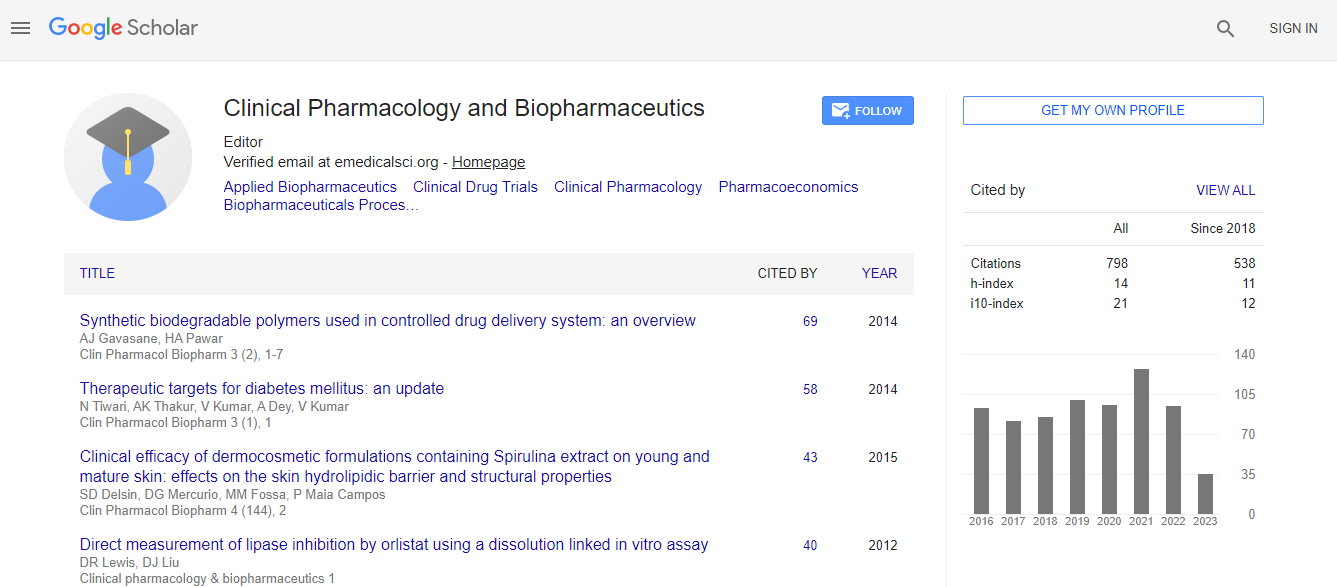Our Group organises 3000+ Global Conferenceseries Events every year across USA, Europe & Asia with support from 1000 more scientific Societies and Publishes 700+ Open Access Journals which contains over 50000 eminent personalities, reputed scientists as editorial board members.
Open Access Journals gaining more Readers and Citations
700 Journals and 15,000,000 Readers Each Journal is getting 25,000+ Readers
Google Scholar citation report
Citations : 1089
Clinical Pharmacology & Biopharmaceutics received 1089 citations as per Google Scholar report
Clinical Pharmacology & Biopharmaceutics peer review process verified at publons
Indexed In
- CAS Source Index (CASSI)
- Index Copernicus
- Google Scholar
- Sherpa Romeo
- Genamics JournalSeek
- RefSeek
- Hamdard University
- EBSCO A-Z
- OCLC- WorldCat
- Publons
- Euro Pub
- ICMJE
Useful Links
Recommended Journals
Related Subjects
Share This Page
Fe(II)-triggered delivery of falcipain inhibitors to the digestive vacuole of malaria parasite
International Conference and Expo on Biopharmaceutics
Francisca Lopes
University of Lisbon, Portugal
Posters-Accepted Abstracts: Clin Pharmacol Biopharm
Abstract
Malaria remains one of the major infectious diseases in man with 198 million cases and almost 600000 deaths reported in 2013. Currently, artemisinin-based combination therapies (ACTs) are the recommended first-line treatment of uncomplicated Plasmodium falciparum malaria worldwide. Artemisinin and other endoperoxides are highly active against the asexual erythrocytic stage of infection. Intracellular localization studies suggest that endoperoxides preferentially accumulate in the P. falciparum food vacuole, the organelle in which host hemoglobin is digested during the intra-erythrocytic life cycle of malaria parasites. These compounds are reductively activated in the presence of Fe(II), accumulated inside the parasite food vacuole as a result of the digestion of hemoglobin, to form carbon-centered radicals capable of reacting with heme and proteins, leading to parasite├ó┬?┬?s death. Dispiro- 1,2,4,5-tetraoxanes are simple, achiral, and highly potent endoperoxides that undergo an iron(II)-heme-triggered fragmentation reaction to generate carbon-centered radicals, that lead to the formation of drug derived-heme adducts, alongside with other metabolites. Inspired on this information, we reasoned that a tetraoxane-based hybrid strategy could be employed to deliver a partner drug, only upon activation by ferrous iron in the parasite. In this communication, we report the design, synthesis and structure├ó┬?┬? activity profiling of tetraoxane-based hybrids containing falcipain inhibitors. Falcipains are cysteine proteases that localize in the food vacuole and play a key role in the hydrolysis of host hemoglobin into amino acids that are essential to parasite growth. We show that iron(II)-heme activation of these hybrids deliver the inhibitor into parasite food vacuole. The results presented indicate that the intrinsic activity of the tetraoxane partner compound can be masked, suggesting that a tetraoxane-based delivery system offers the potential to attenuate the off-target effects of known drugs.Biography
Email: fclopes@ff.ul.pt

 Spanish
Spanish  Chinese
Chinese  Russian
Russian  German
German  French
French  Japanese
Japanese  Portuguese
Portuguese  Hindi
Hindi 
